I learned to caponize roosters by reading Caponizing By LOYL STROMBERG and the sears Caponizing guide found at http://www.afn.org/~poultry/capon.htm I would suggest reading both.
My tools came from Nasco. (With some modifications)
It is very important that you have a very good bright light source. I use a headlight LED light that straps onto my noggin and is extremely bright. Paper towels are also a must!
As of now I have successfully caponized 27 Roosters and only lost 2!
They have all been 6 weeks old, so older birds may require a different procedure.
The first was the first one I tried and the second was due to a nick in the artery near the back bone.
My hope is that this may be part of a start of a new caponizing movement.
The first step to caponize is to starve the birds to reduce the size if the internal organs.
36 hours without food and 24 hours without water. For example on Thursday at 8PM I took the food away. On Friday at 8AM I took away the water and put the roosters in cages in my basement. On Saturday after 8 AM I was ready to get started.
The actual surgery process is as follows:
Immobilize the bird to a board, table, etc. with string and weights. Or use taught line hitches as I did.
Pull the skin under the wing toward the tail feathers and clean the area with an antiseptic. I used rubbing alcohol . The skin is pulled so that the opening in the skin and the one in the body cavity will NOT line up when released. This way stitches will not be required. Locate the ribs and the incision point. See pic below.

I doctored up the pic with black lines to show the ribs. The red line is the cut location. It is between the ribs closest to the hip.
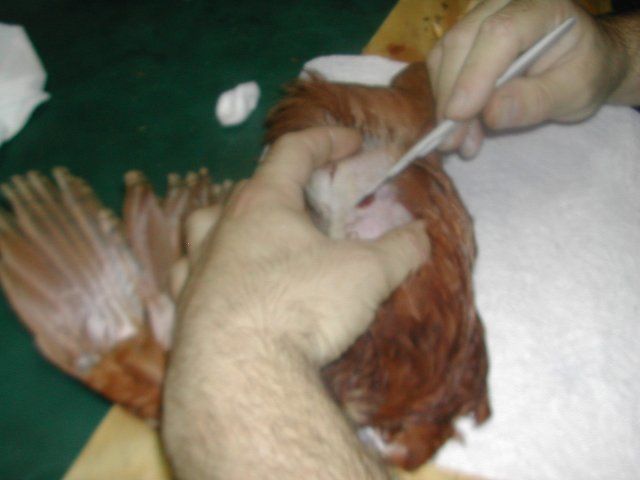
When you make the cut be sure to have a cotton ball ready to collect any blood. I had some birds bleed a lot and others did not bleed at all.
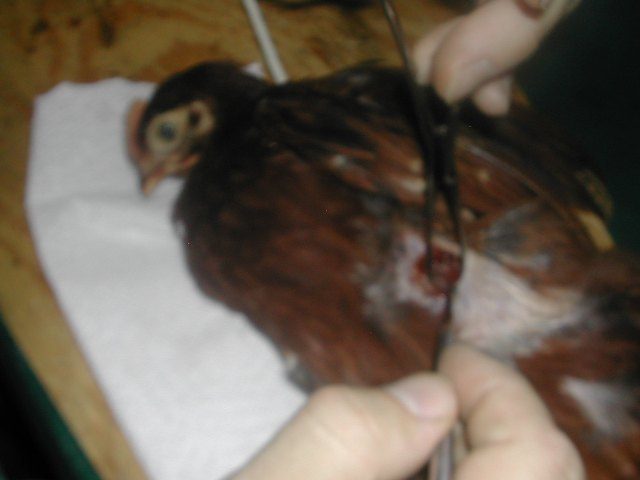
After the cut through the skin and ribcage I insert my forceps into the opening to use as spreaders and use the membrane puller/ripper to locate the testicles. At this point I have noticed that the bird might try to make sounds but the air comes out through the incision. (kinda Weird.)
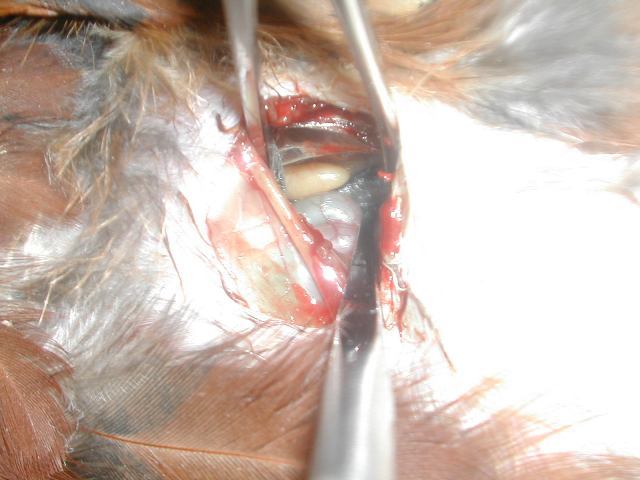
As you can see in the pic you are looking for the bean like gland.
At this point I also check to see if I can find the other gland deeper down in order to remove both glands from one side. Much care must be taken when doing this because you can lose a bird quickly if nick the artery in the same area. At first you should stick to making incisions on both sides of the rooster to avoid death of the bird.
When I am ready to remove the gland(s) I remove the tools, see below.
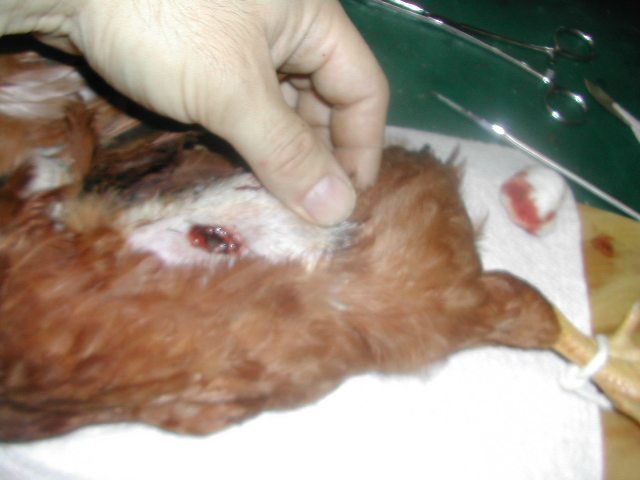
I then and only then use the spreaders to see in the bird and then remove the gland(s) with the forceps.
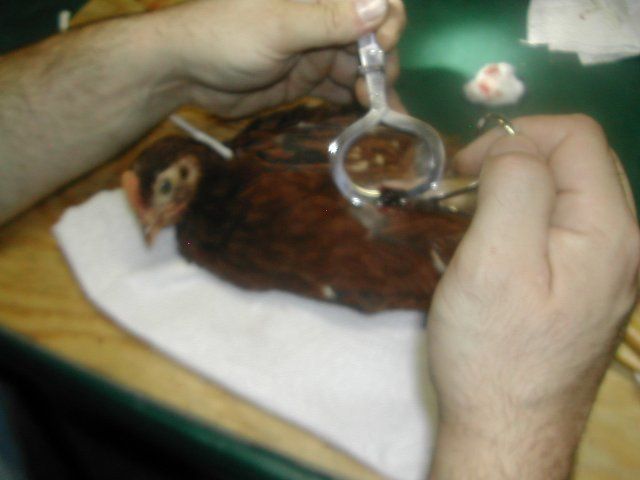
I have never had to cut any loose. They always tear off before I could ever cut anything.
Repeat process on other side if you did not remove both glands.
At the end I just remove all tools, release the skin to cover up the hole in the body cavity and untie the bird.
I put them with other caponized birds with food and water. Some people may want to give them medication but I have not done so and have not had a problem.
A week later the skin should be completely healed. However I dont think the hole in the body cavity is healed yet. I have seen some birds kind of blow up like balloons under the skin! After awhile the air will just go away on its own.
If someone has other experiences or methods please share them with the rest of us on BYC.
My tools came from Nasco. (With some modifications)
It is very important that you have a very good bright light source. I use a headlight LED light that straps onto my noggin and is extremely bright. Paper towels are also a must!
As of now I have successfully caponized 27 Roosters and only lost 2!
They have all been 6 weeks old, so older birds may require a different procedure.
The first was the first one I tried and the second was due to a nick in the artery near the back bone.
My hope is that this may be part of a start of a new caponizing movement.
The first step to caponize is to starve the birds to reduce the size if the internal organs.
36 hours without food and 24 hours without water. For example on Thursday at 8PM I took the food away. On Friday at 8AM I took away the water and put the roosters in cages in my basement. On Saturday after 8 AM I was ready to get started.
The actual surgery process is as follows:
Immobilize the bird to a board, table, etc. with string and weights. Or use taught line hitches as I did.
Pull the skin under the wing toward the tail feathers and clean the area with an antiseptic. I used rubbing alcohol . The skin is pulled so that the opening in the skin and the one in the body cavity will NOT line up when released. This way stitches will not be required. Locate the ribs and the incision point. See pic below.

I doctored up the pic with black lines to show the ribs. The red line is the cut location. It is between the ribs closest to the hip.

When you make the cut be sure to have a cotton ball ready to collect any blood. I had some birds bleed a lot and others did not bleed at all.

After the cut through the skin and ribcage I insert my forceps into the opening to use as spreaders and use the membrane puller/ripper to locate the testicles. At this point I have noticed that the bird might try to make sounds but the air comes out through the incision. (kinda Weird.)

As you can see in the pic you are looking for the bean like gland.
At this point I also check to see if I can find the other gland deeper down in order to remove both glands from one side. Much care must be taken when doing this because you can lose a bird quickly if nick the artery in the same area. At first you should stick to making incisions on both sides of the rooster to avoid death of the bird.
When I am ready to remove the gland(s) I remove the tools, see below.

I then and only then use the spreaders to see in the bird and then remove the gland(s) with the forceps.

I have never had to cut any loose. They always tear off before I could ever cut anything.
Repeat process on other side if you did not remove both glands.
At the end I just remove all tools, release the skin to cover up the hole in the body cavity and untie the bird.
I put them with other caponized birds with food and water. Some people may want to give them medication but I have not done so and have not had a problem.
A week later the skin should be completely healed. However I dont think the hole in the body cavity is healed yet. I have seen some birds kind of blow up like balloons under the skin! After awhile the air will just go away on its own.
If someone has other experiences or methods please share them with the rest of us on BYC.



